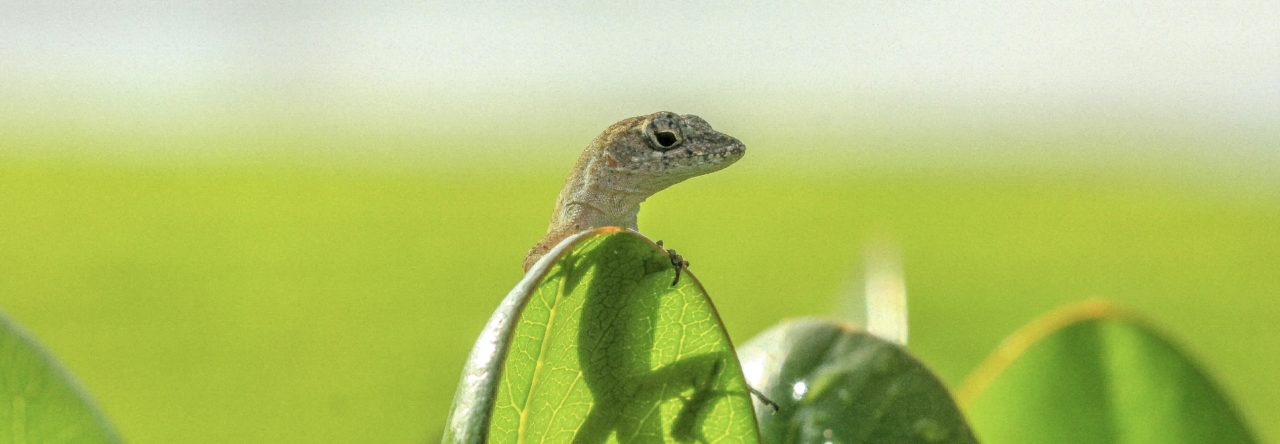
Adult male Anolis onca from Isla de Margarita basking.
Continuing the recent interesting post on the Beach Anole Anolis onca, I decided to write something about my personal experiences with this amazing species and attempt to summarize some of what already exists in the literature. Famous by its lack of expanded, smooth, infradigital lamellae, there is a lot more to these beautiful lizard.

Typical habitat of Anolis onca on Isla de Margarita
This “beach” anole is basically endemic to Venezuela (it is also found on a narrow portion of adjacent Colombia). Within Venezuela, Anolis onca has a disjunct distribution (more on that below). It ranges continuously along the coast of the states of Zulia and Falcon in the West. It is also found on the islands of La Tortuga and Margarita, as well as along the coast of the state of Sucre in the East. Another, possibly disjunct population has surprisingly been recorded from dry savannas well inland in the state of Monagas! I have observed A. onca in western Venezuela, but I am most familiar with populations from Isla de Margarita. I have traveled countless times to the island and since I was a kid I always remember being fascinated by these fairly large, active anoles. On Isla de Margarita, A. onca is definitely ubiquitous. It is easily found on thorn scrubland, coastal sand-dune environments, and beaches. It is also common around human habitation. I have always observed this anole in sites with constant and strong wind currents. Several authors have suggested that the windy conditions present in the habitats preferred by this lizard may have prevented it from being strictly arboreal like other anoles (Williams, 1974; Miyata, 1975; Kiester, 1977).

These guys have a really large, beautiful dewlap
Whatever the case, it is definitely more terrestrial than other anoles (even species that are commonly found on the ground, e.g. Anolis planiceps) and I have observed it numerous occasions on open ground. However, it often climbs up to about 1.5 m on shrubs, cacti, vines or rocks. Around human habitation it also perches on unfinished walls of buildings, cobble and fence posts (same places frequented by the larger Tropidurus hispidus on the island). I also have observed A. onca on open sand banks of beaches in close proximity to salt water (Ugueto and Rivas, 2010). Williams (1974) also mentioned finding this species near the seashore. Interestingly, light colored specimens are very well camouflaged amidst the sandy soil. I have noticed that when A. onca perches on low shrubbery it often just exposes its head above the leaves. I do not recall seeing such behavior in other anole species.
Most individuals remain motionless when first spotted. If you get too close for comfort, lizards invariably run towards and hide within nearby bushes, clumps of herbaceous vegetation or thorny shrubs. Occasionally they may hide beneath rocks or boulders. Collins (1971) reported that some specimens escape into Ocypode crab holes after lizards were pursued for long time, but I have never observed this behavior. Various types of small arthropods like grasshoppers, robber flies, beetles and spiders have been reported as prey (Roze, 1964; Kiester, 1977; Ugueto and Rivas, 2010). Kiester (1977) reported that the analysis of 38 stomachs revealed that a particular species of chrysomelid beetle constituted a large portion of the diet in western Venezuelan lizards. Saurophagy has also been reported in this species; Miyata (1975) and Kiester (1977) recorded a large individual preying on a female Cnemidophorus lizard in northwestern Venezuela. I observed this species preying on small flies that passed near the lizard on a beach on Isla de Margarita. Kiester (1977), however described a very interesting mode of predation in which the lizard stalked fast moving robber flies in a cat-like fashion using the irregularities of the terrain as cover and dashing towards prey when at close range. What is known about the reproduction of this species is fragmentary at best, but it appears it could be seasonal on northwestern Venezuela. Kiester (1977) reported females laid eggs after the rainy season so that hatchlings come out during January, February and probably March.

Distribution of Anolis onca and the closely allied Anolis annectens in Venezuela. Notice the disjunct distribution of onca.
As I mentioned earlier, the distribution of A. onca in Venezuela is disjunct and the western and eastern population are separated by a long stretch of apparently suitable habitat.
Read More



























